
The yellow-wattled lapwing is a lapwing that is endemic to the Indian Subcontinent. It is found mainly on the dry plains of peninsular India and has a sharp call and is capable of fast flight. Although they do not migrate, they are known to make seasonal movements in response to rains. They are dull grey brown with a black cap, yellow legs and a triangular wattle at the base of the beak. Like other lapwings and plovers, they are ground birds and their nest is a mere collection of tiny pebbles within which their well camouflaged eggs are laid. The chicks are nidifugous, leaving the nest shortly after hatching and following their parents to forage for food.

The giant muntjac, sometimes referred to as the large-antlered muntjac, is a species of muntjac deer. It is the largest muntjac species and was discovered in 1994 in Vũ Quang, Hà Tĩnh Province of Vietnam and in central Laos. During inundation of the Nakai Reservoir in Khammouane Province of Laos for the Nam Theun 2 Multi-Purpose Project, 38 giant muntjac were captured, studied, and released into the adjacent Nakai-Nam Theun National Protected Area. Subsequent radio-tracking of a sample of these animals showed the relocation was successful. The species is also located in parts of eastern Cambodia, as well as the Annamite Mountains.

The Truong Son muntjac or Annamite muntjac is a species of muntjac deer. It is one of the smallest muntjac species, at about 15 kg (33 lb), half the size of the Indian muntjac. It was discovered in the Truong Son (Annamite) mountain range in Vietnam in 1997.
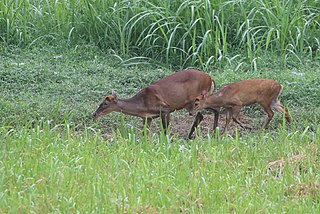
Muntjacs, also known as the barking deer or rib-faced deer, are small deer of the genus Muntiacus native to South Asia and Southeast Asia. Muntjacs are thought to have begun appearing 15–35 million years ago, with remains found in Miocene deposits in France, Germany and Poland. Most are listed as least-concern species or Data Deficient by the International Union for Conservation of Nature (IUCN), although others such as the black muntjac, Bornean yellow muntjac, and giant muntjac are vulnerable, near threatened, and critically endangered, respectively.
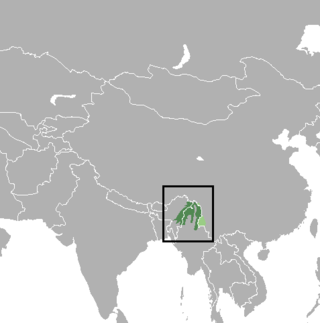
The leaf muntjac, leaf deer or Putao muntjac is a small species of muntjac. It was documented in 1997 by biologist Alan Rabinowitz during his field study in the isolated Nogmung Township in Myanmar. Rabinowitz discovered the species by examining the small carcass of a deer that he initially believed was the juvenile of another species; however, it proved to be the carcass of an adult female. He managed to obtain specimens, from which DNA analysis revealed a new cervid species. Local hunters knew of the species and called it the leaf deer because its body could be completely wrapped by a single large leaf. It is found in Myanmar and India.

The southern red muntjac is a deer species native to Southeast Asia. It was formerly known as the Indian muntjac or the common muntjac before the species was taxonomically revised to represent only populations of Sunda and perhaps Malaysia. The other populations being attributed to this species are now attributed to Muntiacus vaginalis. Muntjacs are also referred to as barking deer. It is listed as Least Concern on the IUCN Red List.

Reeves's muntjac, also known as the Chinese muntjac, is a species of muntjac found widely in south-eastern China and Taiwan. It has also been introduced in the United Kingdom, Ireland, the Netherlands, Belgium, and Japan. It takes its name from John Reeves, a naturalist employed by the British East India Company in the 19th century.
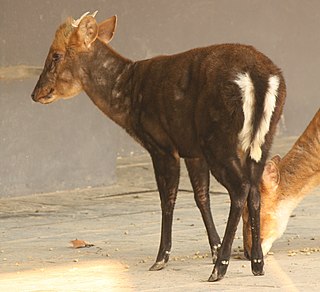
The hairy-fronted muntjac or black muntjac is a type of deer currently found in Zhejiang, Anhui, Jiangxi and Fujian in southeastern China. It is considered to be endangered, possibly down to as few as 5–10,000 individuals spread over a wide area. Reports of hairy-fronted muntjacs from Burma result from considering the hairy-fronted muntjac and Gongshan muntjac as the same species. This suggestion is controversial. It is similar in size to the common muntjac.
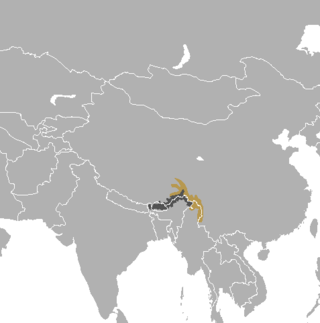
The Gongshan muntjac is a species of muntjac living in the Gongshan mountains in northwestern Yunnan, southeast Tibet, Northeast India and northern Myanmar.

The Fea's muntjac or Tenasserim muntjac is a rare species of muntjac native to southern Myanmar and Thailand. It is a similar size to the common muntjac . It is diurnal and solitary, inhabiting upland evergreen, mixed or shrub forest with a diet of grasses, low-growing leaves, and tender shoots. The young are usually born in dense vegetation, remaining hidden until able to travel with the mother.

A single specimen of the Roosevelt's muntjac or Roosevelt's barking deer was presented to the Field Museum in 1929 following the Kelley-Roosevelts expedition organized by Theodore (Jnr) and Kermit Roosevelt. The specimen is slightly smaller than the common muntjac and DNA testing has shown it to be distinct from recently discovered muntjac species. It is a subspecies of Fea's muntjac, whose home range is mountains further northwest separated by lower land. However, without further evidence, the exact position of Roosevelt's muntjac cannot be stated. Berlin Zoo supposedly held this species between 1961 and 1972 but it could have been an Indian muntjac, subspecies annamensis.
The Bornean yellow muntjac is a muntjac deer species, endemic to the moist forests of the island of Borneo.
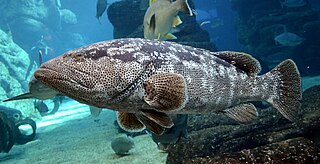
The Malabar grouper also known as blackspot rockcod, estuary rockcod, giant rock cod, greasy grouper, Malabar rockcod, Morgan's cod or speckled grouper, is a species of marine ray-finned fish, a grouper from the subfamily Epinephelinae which is part of the family Serranidae, which also includes the anthias and sea basses. It is found in the Indo-Pacific region. It has entered the Mediterranean Sea from the Red Sea by way of the Suez Canal as a Lessepsian migrant.

Hortus Malabaricus is a 17th-century Latin botanical treatise documenting the varieties and medicinal properties of the flora of the Malabar coast. It was compiled in 12 volumes by Hendrik van Rheede, the Governor of Dutch Malabar from 1669 to 1676. Fr. Matheus of St. Joseph OCD a distinguished herbalist, was an Italian Carmelite Missionary and Van Rheede's friend.

Kattungal Subramaniam Manilal is an Emeritus of the University of Calicut, a botany scholar and taxonomist, who devoted over 35 years of his life to research, translation and annotation work of the Latin botanical treatise Hortus Malabaricus. This epic effort brought to light the main contents of the book, a wealth of botanical information on Malabar that had largely remained inaccessible to English-speaking scholars, because the entire text was in the Latin language.
The Sumatran muntjac is a subspecies of Indian muntjac in the deer family which can be the size of a large dog. It was discovered in 1914, but had not been sighted since 1930 until one was snared and freed from a hunter's snare in Kerinci Seblat National Park, Sumatra, Indonesia in 2002. Two other Sumatran muntjac have since been photographed in the park. The Sumatran muntjac was placed on the IUCN Red List in 2008, but was listed as Data Deficient, as taxonomic issues are still unresolved. The distribution of the taxon is also uncertain and may be more extensive than suggested. It is possible that some previous sightings of the common muntjac in Western Sumatra were the Sumatran muntjac.
The Pu Hoat muntjac is a species of muntjac only known from Pu Hoat region in Vietnam, which is bordering Laos. It is sometimes considered to be conspecific with Roosevelt's muntjac, and its habitat and behavior are likely to be similar.

Hoplias malabaricus, also known as the wolf fish, tiger fish, guabine or trahira, is a predatory Central and South American freshwater ray-finned fish of the characiform family Erythrinidae.

Lutjanus malabaricus, the Malabar blood snapper, saddletail snapper, large-mouthed nannygai, large-mouthed sea-perch, Malabar snapper, nannygai, red bass, red bream, red emperor, red Jew, red snapper, saddletail seaperch, scarlet emperor or scarlet sea-perch, is a species of marine ray-finned fish, a snapper belonging to the family Lutjanidae. It is native to the Indian Ocean and the western Pacific, where it is found east to Fiji and Japan.















